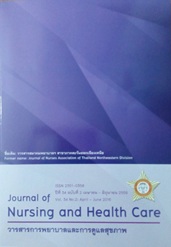ความสัมพันธ์ระหว่างอายุมารดา อายุครรภ์ ลำดับที่ของการตั้งครรภ์และ ความกลัวที่เกี่ยวข้องกับการตั้งครรภ์และการคลอดของสตรีตั้งครรภ์ Relationship between Maternal Age, Gestational Age, Number of Pregnancies and Fears Associated with Pregnancy and Childbirth
คำสำคัญ:
ความกลัว การตั้งครรภ์ การคลอด ความกลัวที่เกี่ยวข้องกับการตั้งครรภ์และการคลอด fear of pregnancy, fear of childbirthบทคัดย่อ
สตรีตั้งครรภ์มีการเปลี่ยนแปลงด้านร่างกาย จิตใจ และอารมณ์อย่างมากในระยะตั้งครรภ์ สภาพดังกล่าว
เป็นภาวะที่ไม่สามารถคาดเดาความผิดปกติที่อาจเกิดขึ้นกับมารดาและทารกในครรภ์ได้ สตรีตั้งครรภ์จึงเกิดความ
วิตกกังวล ความเครียด ส่งผลต่อภาวะสุขภาพของสตรีตั้งครรภ์และทารกในครรภ์ได้ การศึกษานี้เป็นการศึกษา
เชิงปริมาณ มีวัตถุประสงค์เพื่อศึกษาความกลัวที่เกี่ยวข้องกับการตั้งครรภ์และการคลอด รวมทั้งศึกษาความสัมพันธ์
ระหว่างอายุของมารดา อายุครรภ์ ลำดับที่ของการตั้งครรภ์และความกลัวที่เกี่ยวข้องกับการตั้งครรภ์และการคลอด
ของสตรีตั้งครรภ์ที่มาฝากครรภ์ ณ โรงพยาบาลส่งเสริมสุขภาพตำบล ในเขตอำเภอเมืองอุดรธานี จังหวัดอุดรธานี การ
คัดเลือกกลุ่มตัวอย่างใช้การสุ่มตัวอย่างแบบโควตา จำนวน 320 ราย ส่วนการรวบรวมข้อมูล ใช้แบบสอบถามข้อมูล
ส่วนบุคคล แบบประเมินความกลัวที่เกี่ยวข้องกับการตั้งครรภ์และการคลอด การวิเคราะห์ข้อมูลส่วนบุคคล คำนวณ
โดยการใช้สถิติการแจกแจงความถี่ ร้อยละ และความสัมพันธ์ระหว่างตัวแปรด้วยสัมประสิทธิ์สหพันธ์ของเพียร์สัน
ผลการศึกษา พบว่า สิ่งที่สตรีตั้งครรภ์กลัว 3 อันดับแรก คือ กลัวเกี่ยวกับการตั้งครรภ์และการคลอด ได้แก่
ความกลัวเกี่ยวกับการคลอด ( = 2.77, S.D. = 0.65) และรองลงมา คือ ความกลัวเกี่ยวกับภาวะสุขภาพของตนเองและทารก ( = 2.75, S.D. = 0.81) และความกลัวการได้รับผ่าตัดคลอด ( = 2.49, S.D. = 1.01) ตามลำดับ ส่วนสาเหตุที่ก่อให้เกิดความกลัว ได้แก่ การได้รับข้อมูลข่าวสารที่เป็นอันตรายจากเจ้าหน้าที่ ( = 2.22, S.D. = 0.81)และรองลงมา คือ สตรีตั้งครรภ์มีอารมณ์ด้านลบ ( = 2.06, S.D. = 0.68) ตลอดจนการได้รับรู้เรื่องราวด้านลบ( = 1.98 , S.D.= 0.74) ความกลัวมีอิทธิพลต่อชีวิตประจำวัน ( = 1.27, S.D. = 0.43) และทำให้มีอาการเครียด( = 1.27, S.D. = 0.43) นอกจากนี้ พบว่า อายุของมารดามีความสัมพันธ์ทางลบกับสิ่งที่สตรีตั้งครรภ์กลัวและสาเหตุของความกลัวอย่างมีนัยสำคัญทางสถิติที่ระดับ 0.01 (r = - 0.213 และ - 0.235 ตามลำดับ) อีกทั้งลำดับที่ของการตั้งครรภ์มีความสัมพันธ์ทางลบกับสิ่งที่สตรีตั้งครรภ์กลัว และมีความสัมพันธ์ทางบวกกับสาเหตุของความกลัวอย่างมีนัยสำคัญทางสถิติที่ระดับ 0.01 (r = - 0.220 และ 0.150 ตามลำดับ)จากผลการศึกษา สรุปได้ว่า พยาบาลในคลินิกฝากครรภ์ควรตระหนักและประเมินความรู้สึกต่อการตั้งครรภ์และการคลอดโดยเฉพาะสตรีตั้งครรภ์ที่มีอายุน้อย และสตรีตั้งครรภ์แรกที่มารับบริการฝากครรภ์ เมื่อพบว่ามีความกลัวเกิดขึ้นควรให้การดูแลที่เหมาะสม พร้อมทั้งจัดกิจกรรมทางการพยาบาลเพื่อลดความกลัว
During pregnancy, there are many physiological and psycho-emotional changes. Pregnancy is also unpredictable conditions in any abnormalities on mother and the baby. These cause anxiety, stress, and fear to pregnant women. This quantitative study aimed to investigate the fears associated with pregnancy and childbirth. Its objective included the relationships between maternal age, gestational age, number of pregnancies, and the fears associated with pregnancy and childbirth among pregnant women who received the antenatal care at sub-district health promotion hospitals, Muang district, Udonthani Province. The quota sampling was used and gathered 320 pregnant women. The data were collected using the
Demographic data sheet and the Pregnancy and Childbirth - related Fears – questionnaire (PCF- 2008).Descriptive statistics and Pearson’s Product Moment correlation coefficient were used for data analysis.The results of the study showed that the first three highest average scores of the women fear about pregnancy and childbirth were: 1) fear for child delivery ( = 2.77, S.D. = 0.65); 2) fear for their own and babies’ health status ( = 2.75, S.D. = 0.81); and 3) fear of getting cesarean ( = 2.49, S.D. = 1.01). The important causes of fears were receiving frightened information from health care providers ( = 2.22,S.D. = 0.81), their own negative emotion ( = 2.06, S.D. = 0.68), and the perceiving of the negative stories ( = 1.98, S.D. = 0.74). The fears affected to the women’s daily life ( = 1.27, S.D. = 0.43) and caused to stress ( =1.27, S.D. = 0.43). In addition, there were significantly negative correlation between maternal age and objects of fear (r = -0.213), as well as maternal age and causes of fear (r = -0.235) at p- value <0.01. The order of pregnancy was significantly negative correlation to objects of fear (r = -0.220 and significantly positive correlation to causes of fears(r = 0.150) at p- value <0.01. This present study findings mean to nurses in the antenatal care unit in terms of concerning, assessment and appropriate intervention about fears of pregnant women at the very beginning of pregnancy, especially for the young and first women with pregnancy.



